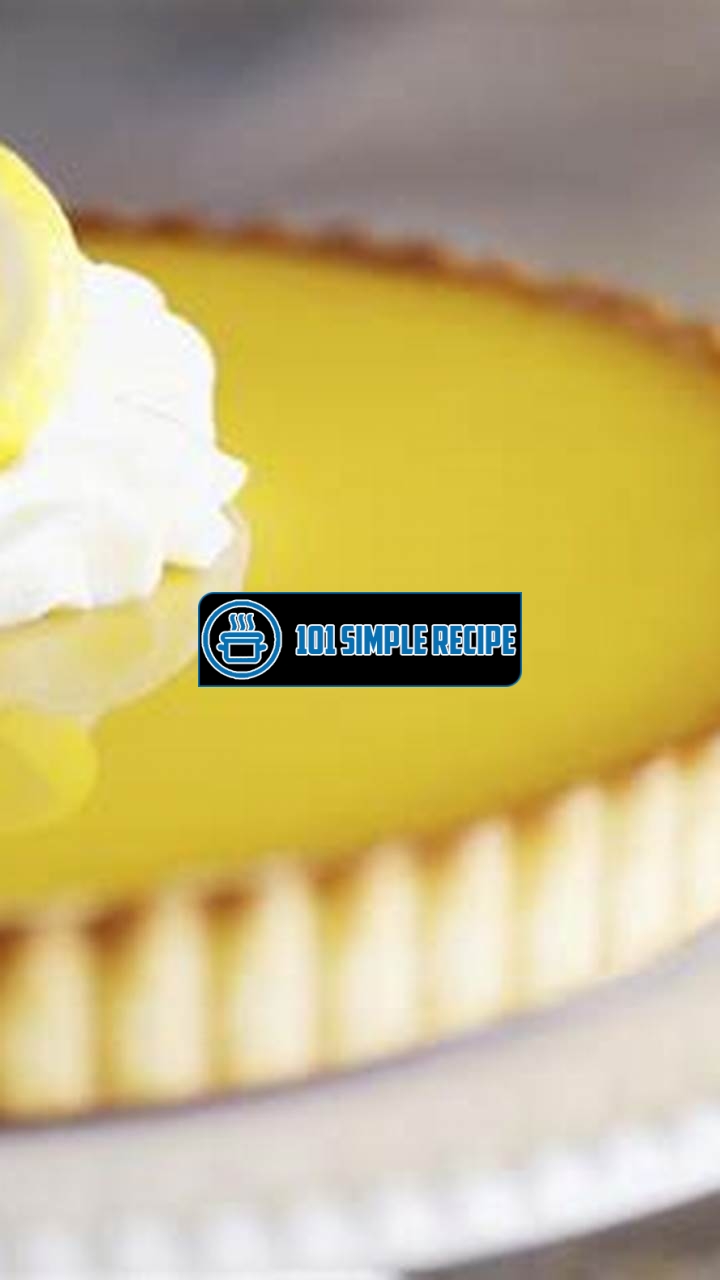Looking for a delectable lemon tart recipe that will impress your guests at any occasion? Look no further! This lip-smacking dessert is the perfect combination of tangy and sweet, with a buttery crust that will melt in your mouth. Whether you’re hosting a dinner party, celebrating a special event, or simply craving a delicious treat, this lemon tart recipe is sure to satisfy your taste buds. Follow along as we guide you through the steps to create this delightful dessert that will leave everyone asking for seconds. With its vibrant yellow color and refreshing flavor, this lemon tart will be a show-stopper on any dessert table.

Exploring the Delightful World of Lemon Tart
Discover the joys of baking and savoring a homemade lemon tart with this comprehensive guide. Lemon tarts are a timeless dessert that can be enjoyed all year round. The combination of tangy lemon curd and flaky tart shell creates a perfect balance of flavors and textures. Whether you’re a seasoned baker or just starting out, this lemon tart recipe is sure to impress.
Mastering the Perfect Lemon Curd
The star of any lemon tart is the luscious lemon curd. To achieve the perfect balance of sweet and tangy flavors, it’s important to master the art of making lemon curd. Here’s how:
- Choose the right lemons: Start by selecting fresh and juicy lemons. The zest and juice of lemons will provide the intense citrusy flavor that makes the curd so delicious.
- Whisk the ingredients: In a saucepan, whisk together the lemon zest, lemon juice, sugar, eggs, and butter. It’s important to continually whisk the mixture to ensure a smooth and creamy consistency.
- Cook over low heat: Place the saucepan over low heat and cook the mixture while stirring constantly. This slow cooking process helps to thicken the curd and intensify the flavors.
- Strain the curd: Once the curd reaches a thick consistency, remove it from the heat and strain it through a fine-mesh sieve. This step ensures a silky smooth texture.
- Chill and refrigerate: Transfer the curd to a bowl and cover it with plastic wrap, making sure the wrap touches the surface of the curd to prevent a skin from forming. Refrigerate the curd for at least two hours, allowing it to set and thicken further.
Creating the Flaky Tart Shell
The tart shell serves as the foundation for your lemon tart. To achieve a flaky and buttery crust, follow these steps:
- Prepare the dough: In a large mixing bowl, combine flour, sugar, and salt. Cut cold butter into small pieces and add it to the dry ingredients. Use a pastry cutter or your fingertips to rub the butter into the flour until the mixture resembles coarse crumbs.
- Add liquid: Gradually add ice-cold water to the dough, one tablespoon at a time, and mix until the dough comes together. Be careful not to overmix, as this can result in a tough crust.
- Chill the dough: Wrap the dough in plastic wrap and refrigerate for at least 30 minutes. This resting time allows the gluten to relax and helps prevent shrinkage during baking.
- Roll out the dough: On a lightly floured surface, roll out the chilled dough into a circle large enough to fit your tart pan. Gently transfer the dough to the pan and press it into the bottom and sides.
- Bake the tart shell: Preheat the oven and blind bake the tart shell by lining it with parchment paper or aluminum foil and filling it with pie weights or dried beans. Bake for about 15 minutes, then remove the weights and continue baking for another 10 minutes until the shell is golden brown.
Assembling and Baking the Lemon Tart
Once you have mastered the lemon curd and created the flaky tart shell, it’s time to assemble and bake the lemon tart. Here’s how:
- Spread the lemon curd: Take the chilled lemon curd and spread it evenly into the pre-baked tart shell. Use a spatula or the back of a spoon to create a smooth and even layer.
- Bake the lemon tart: Preheat the oven to the specified temperature and place the tart on the middle rack. Bake for about 20-25 minutes or until the edges of the tart are golden brown and the curd has set.
- Cool and serve: Once the tart is baked, remove it from the oven and let it cool completely on a wire rack. Refrigerate for a few hours to allow the flavors to meld together. Serve chilled and enjoy!
With this easy lemon tart recipe, you can create a delectable dessert that is perfect for any occasion. Whether it’s a family gathering, a dinner party, or a simple treat for yourself, this lemon tart is sure to impress your taste buds. So, put on your apron, gather your ingredients, and let the delightful journey of baking a homemade lemon tart begin.
Unleashing the Tangy Flavor
In this section, you will discover the key ingredients and techniques that work together to create a lemon tart bursting with tangy goodness. From the zestful power of lemons to the sweet symphony of sugar and the creamy elegance of butter, each element plays a crucial role in achieving the perfect balance of flavors. Get ready to embark on a culinary adventure!
The Zestful Power of Lemons
The first ingredient that sets the stage for the tangy flavor profile of a lemon tart is, of course, lemons themselves. Lemons are renowned for their vibrant and refreshing taste, thanks to their high citric acid content. The tartness of lemons adds a zingy kick to the taste buds, making them a perfect choice for a dessert like lemon tart.
Furthermore, the zest of the lemon is where a lot of its aromatic oils reside. By using the zest, which is the outer yellow part of the skin, you can enhance the lemon flavor in your tart. Just a touch of grated lemon zest will infuse a burst of tangy fragrance into every bite, elevating the overall taste experience.
The Sweet Symphony of Sugar
No lemon tart would be complete without a sweet counterbalance to the tartness of lemons. Enter sugar, the second key ingredient that helps create a harmonious flavor profile. Sugar adds a touch of sweetness that softens the tangy edges of the lemons and brings balance to the dessert.
When incorporating sugar into your lemon tart, consider using both granulated sugar and powdered sugar. Granulated sugar provides sweetness and structure to the tart filling, while powdered sugar adds a velvety texture and enhances the overall sweetness. The combination of these two sugars creates a symphony of flavors that will tantalize your taste buds.
The Creamy Elegance of Butter
Last but certainly not least, we have butter. Butter plays a crucial role in achieving the creamy and luscious texture that makes a lemon tart so irresistible. It not only adds richness but also helps bind the ingredients together, resulting in a smooth and velvety filling.
When selecting butter for your tart, opt for unsalted butter. This allows you to have full control over the saltiness in your recipe. Additionally, using butter at room temperature ensures easy incorporation and a homogenous mixture, resulting in a perfectly creamy lemon tart.
In conclusion, the key to a delicious lemon tart lies in the careful selection and combination of ingredients. Lemons bring the tangy flavor, sugar adds sweetness, and butter creates the creamy texture. By utilizing the zest of lemons, you can further intensify the lemony goodness. So, gather your ingredients, unleash your creativity, and savor the delightful tangy symphony of flavors that a homemade lemon tart offers.
Adding a Dash of Creativity
When it comes to creating a truly extraordinary lemon tart, adding a dash of creativity can take your dessert to new heights. By infusing delicate flavors with herbs, experimenting with citrus variations, and garnishing for visual appeal, you can elevate a simple lemon tart into a culinary masterpiece. So let’s dive into these exciting twists and enhancements that will surely impress your taste buds.
Infusing Delicate Flavors with Herbs
One way to elevate the flavor of your lemon tart is by infusing delicate flavors with herbs. Consider adding a touch of fresh lavender to the tart filling for a subtle floral note that complements the tartness of the lemon. Alternatively, you can experiment with thyme or rosemary to create an earthy and aromatic twist. By gently incorporating these herbs into the filling, you’ll add depth and complexity to your tart, making it stand out from the crowd.
Don’t limit yourself to just herbs, though. Get creative with other flavor pairings that complement lemon. For example, a hint of basil can provide a refreshing and slightly peppery taste, while mint can add a cool and vibrant element. The key is to experiment and find the herb that best enhances the flavor profile of your lemon tart.
Experimenting with Citrus Variations
If you’re looking to add an extra zing to your lemon tart, experimenting with citrus variations is the way to go. Consider incorporating the zest or juice of other citrus fruits, such as lime or orange, into your tart filling. This will not only intensify the citrus flavor but also add layers of complexity. The tartness of the lemon combined with the tanginess of lime or the sweetness of orange creates a delightful symphony of flavors.
Additionally, you can enhance the texture of your lemon tart by incorporating citrus segments. For example, add thinly sliced lemon or orange segments on top of the tart as a garnish. This not only adds visual appeal but also provides bursts of juicy citrus as you take each bite.
Garnishing for Visual Appeal
They say we eat with our eyes first, and that holds true for lemon tarts as well. Enhancing the visual appeal of your tart can make it even more enticing. Consider garnishing your tart with edible flowers, such as pansies or violets, for a pop of color and a touch of elegance. Alternatively, you can dust the top of the tart with powdered sugar or cocoa powder to create beautiful patterns or designs.
To add a crunchy element, sprinkle slivered almonds or grated coconut on top of the tart before baking. This not only adds texture but also enhances the flavor profile. Additionally, you can drizzle a thin glaze of icing over the tart once it has cooled to give it a glossy and professional finish.
Remember, creativity knows no bounds when it comes to garnishing a lemon tart. Let your imagination run wild and experiment with different decorations, such as chocolate shavings, edible gold leaf, or even a dollop of whipped cream. The key is to create a visually stunning dessert that matches the exquisite taste of your lemon tart.
With these innovative twists and enhancements, you’ll be able to transform a simple lemon tart into a culinary masterpiece that will wow your guests. So get creative, experiment with flavors and garnishes, and enjoy the process of turning an ordinary dessert into an extraordinary experience!
Overcoming Common Lemon Tart Challenges
When it comes to making a delicious lemon tart, there are a few common challenges that home bakers often face. However, with the right techniques and tips, these challenges can be easily overcome. In this article, we will explore how to troubleshoot issues and overcome common hurdles encountered during the lemon tart baking process. Let’s dive in!
Avoiding a Soggy Bottom
One common challenge when baking a lemon tart is ending up with a soggy bottom crust. The key to avoiding this is to blind bake the crust before adding the filling. Blind baking refers to partially baking the crust without any filling. This ensures that the bottom crust is crisp and doesn’t get overly saturated with the lemon filling.
To blind bake the crust, start by preheating your oven to 350°F (175°C). Roll out your pastry dough and press it into a tart pan. Line the dough with parchment paper and fill it with pie weights or dried beans. This will prevent the crust from puffing up during baking. Bake the crust for about 15 minutes, then remove the parchment paper and weights and bake for an additional 5 minutes or until the crust turns golden brown. This will give you a perfectly crispy bottom crust for your lemon tart.
Preventing Overly Tart or Bitter Filling
Another common challenge when making a lemon tart is ending up with an overly tart or bitter filling. To prevent this, it’s important to strike the right balance between sweetness and tartness in your lemon curd. Start by using fresh and ripe lemons for the juiciest and most flavorful results. Taste your lemon curd mixture before pouring it into the pre-baked crust and adjust the sweetness if needed. Adding a tablespoon or two of honey or powdered sugar can help balance the tartness and create a more pleasant flavor profile.
It’s also important to strain your lemon curd mixture before pouring it into the crust. This will remove any zest or solids that can contribute to a bitter taste. Additionally, pay attention to the cooking time and temperature specified in your recipe. Overcooking the lemon curd can result in a tart or bitter flavor. Remove the curd from the heat as soon as it thickens and coats the back of a spoon.
Ensuring a Smooth and Lump-Free Curd
A smooth and lump-free lemon curd is essential for a perfect lemon tart. To achieve this, it’s important to follow a few key steps. Firstly, whisk your egg yolks and sugar together until well combined before adding the lemon juice and zest. This will help distribute the sugar evenly and prevent lumps from forming.
When cooking the lemon curd, use low to medium heat and constantly stir the mixture with a wooden spoon or silicone spatula. This will prevent the curd from sticking to the bottom of the saucepan and forming lumps. If you do end up with lumps, you can strain the curd through a fine mesh sieve to remove them.
In conclusion, by following these tips and techniques, you can overcome common challenges when baking a lemon tart. Avoiding a soggy bottom crust, preventing overly tart or bitter filling, and ensuring a smooth and lump-free curd will help you achieve a delicious and successful lemon tart every time. Happy baking!
Serving and Storage Tips
When it comes to enjoying a delightful lemon tart, there are a few serving and storage tips that can help you make the most of this delectable dessert. By following these suggestions, you can ensure that the taste and texture of your freshly baked lemon tart are preserved for all occasions.
1. Serve at the Right Temperature: For the perfect lemon tart experience, it’s important to serve it at the right temperature. Allow the tart to cool down completely before serving. This will help the flavors meld together and the texture to set properly. A chilled lemon tart is ideal and adds a refreshing touch to each bite.
2. Garnish with Fresh Fruit: To enhance the presentation and flavor of your lemon tart, consider adding a garnish of fresh fruit. Sliced strawberries, raspberries, or blueberries not only add visual appeal but also complement the tartness of the lemon filling. It’s a combination that is sure to wow your guests.
3. Dust with Powdered Sugar: Before serving, dusting your lemon tart with a sprinkle of powdered sugar creates a beautiful finishing touch. It adds a touch of sweetness and provides an inviting appearance that will tempt your taste buds. Just a light dusting is enough to elevate the overall presentation.
Pairing with Complementary Flavors
Pairing your lemon tart with complementary flavors can elevate the taste experience even further. Here are a few options to consider:
- Raspberry Sauce: The tangy sweetness of raspberry sauce pairs perfectly with the zesty flavors of the lemon tart. Drizzle it over each slice just before serving for an added burst of fruity goodness.
- Whipped Cream: A dollop of freshly whipped cream on top of a slice of lemon tart can create a perfect balance of creaminess and tartness. The smooth texture of the cream complements the zingy lemon filling, creating a harmonious combination.
- Vanilla Ice Cream: For a refreshing twist, serve your lemon tart with a scoop of vanilla ice cream. The creamy vanilla flavor and the tangy lemon filling create a delightful contrast that will please your taste buds.
Optimal Storage Techniques
To ensure that your lemon tart stays fresh and delicious, it’s important to store it properly. Follow these storage techniques:
- Refrigeration: Lemon tart should be stored in the refrigerator. Cover it loosely with aluminum foil or plastic wrap to prevent it from drying out. It can be stored for up to three days without compromising its taste and texture. ️
- Individual Containers: If you want to store individual slices or servings of lemon tart, place each piece in an airtight container. This will help maintain its freshness and prevent any odors from seeping in. It’s a convenient method for grab-and-go desserts.
- Avoid Freezing: It’s not recommended to freeze lemon tart as it can alter the texture and affect the overall quality. However, if you must freeze it, wrap it tightly in several layers of plastic wrap and place it in an airtight container. Thaw it in the refrigerator before re-serving. ⛄
Reviving Leftover Lemon Tart
If you find yourself with leftover lemon tart that has lost its freshness or become slightly stale, there are a few tricks to revive it:
- Toast It: One way to bring back the crispness is to toast individual slices of the lemon tart in the oven for a few minutes. This will lightly reheat the tart and restore its flakiness. Remember to keep a close eye on it to prevent burning.
- Add Fresh Fruits: Another way to revive the flavor is by adding fresh fruits. Sliced strawberries, raspberries, or even a drizzle of honey can add a burst of freshness and sweetness to the tart. It’s a simple yet effective solution.
In conclusion, these serving and storage tips will ensure that your lemon tart remains a crowd-pleasing dessert for all occasions. By pairing it with complementary flavors, storing it optimally, and reviving any leftovers creatively, you can savor the delightful taste and texture of your lemon tart for days to come. Enjoy!
Thank you for taking the time to read our lemon tart recipe! We hope you found the instructions clear and easy to follow. We understand that baking can be a fun and rewarding activity, and we are thrilled to be a part of your culinary journey. If you have any questions or concerns, please feel free to reach out to us. We would love to hear about your own experiences with this recipe! Make sure to bookmark our site for more delicious recipes in the future. Happy baking!
Frequently Asked Questions
Here are some frequently asked questions about our lemon tart recipe:
| No. | Questions | Answers |
|---|---|---|
| 1. | Can I use store-bought crust instead of making it from scratch? | Yes, you can definitely use store-bought crust if you prefer a quicker option. Just make sure to follow the instructions on the packaging for pre-baking, if needed. |
| 2. | Can I substitute the lemon juice with bottled lemon juice? | While fresh lemon juice is preferred for the best flavor, you can use bottled lemon juice as a substitute if that’s what you have on hand. Just make sure it’s 100% lemon juice without any added sugars or flavors. |
| 3. | Can I freeze the leftover lemon tart? | Yes, you can freeze the leftover lemon tart. Wrap it tightly in plastic wrap or aluminum foil and place it in an airtight container. It should keep well in the freezer for up to 3 months. |
| 4. | Can I use lime juice instead of lemon juice? | Yes, you can substitute lime juice for a lime tart instead of lemon tart. The flavor will be slightly different, but equally delicious. |
| 5. | Can I add other fruits or toppings to the lemon tart? | Absolutely! You can get creative with your toppings and add fresh berries, whipped cream, or even a dusting of powdered sugar to enhance the presentation and taste. |
| 6. | How long does the lemon tart stay fresh? | The lemon tart will stay fresh for up to 3 days when stored in the refrigerator. Just make sure to cover it tightly with plastic wrap or place it in an airtight container to prevent it from drying out. |
Closing Thoughts
We hope you enjoyed our lemon tart recipe and that it brings a burst of citrusy goodness into your life. Remember, baking is not only about the end result, but also about the joy and satisfaction it brings along the way. So, embrace your inner baker and keep experimenting with new flavors and recipes. Don’t forget to check back for more delectable treats and culinary adventures. Thank you again for joining us on this baking journey!
Jump to Recipe
Lemon Tart Recipe

A tangy and refreshing lemon tart that is perfect for any occasion. With a buttery crust and a smooth, luscious filling, this dessert will surely brighten up your day.
- 1 1/2 cups all-purpose flour
- 1/2 cup unsalted butter (cold and cut into small cubes)
- 1/4 cup granulated sugar
- 1/4 teaspoon salt
- 3 large eggs
- 3/4 cup granulated sugar
- 1/2 cup fresh lemon juice
- 2 tablespoons lemon zest
- 1/4 cup all-purpose flour
- Powdered sugar (for dusting (optional))
- In a food processor, combine the flour, butter, sugar, and salt. Pulse until the mixture resembles coarse crumbs. Gradually add the beaten eggs and pulse until the dough comes together. Shape the dough into a disk, wrap it in plastic wrap, and refrigerate for 30 minutes.
- Preheat the oven to 350°F (175°C).
- On a lightly floured surface, roll out the chilled dough into a circle that is slightly larger than your tart pan. Gently transfer the dough to the tart pan and press it into the bottom and sides. Trim off any excess dough.
- In a medium bowl, whisk together the sugar, lemon juice, lemon zest, flour, and eggs until well combined and smooth.
- Pour the lemon filling into the prepared crust. Bake for 30 minutes, or until the filling is set and the crust is lightly golden. Remove from the oven and let it cool completely on a wire rack.
- Once cooled, you can optionally dust the tart with powdered sugar before serving. Slice and enjoy!






